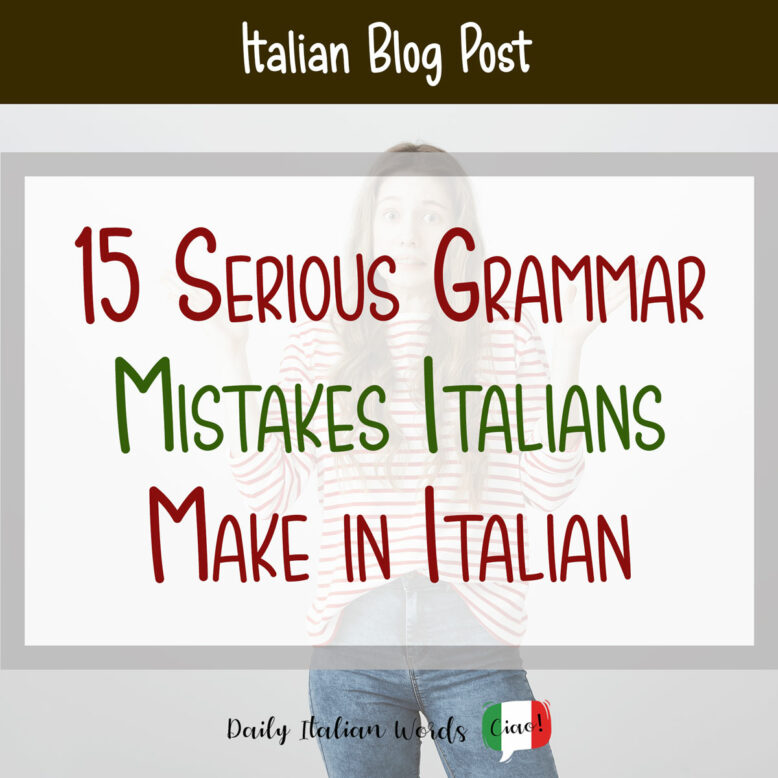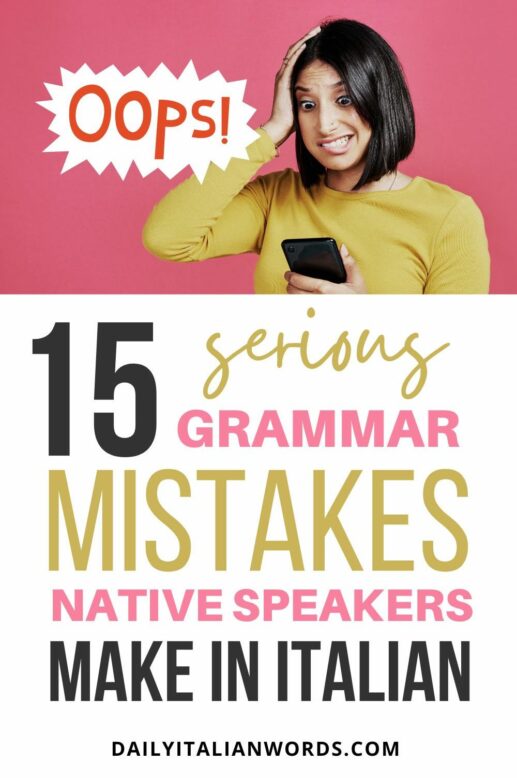Italian is often described as one of the most beautiful and poetic languages in the world. With its soft, melodic sound and rich vocabulary, it’s no wonder many people are drawn to learning it. But make no mistake – while Italian may be beautiful, it can also be quite challenging to learn, with complex grammar and lots of exceptions. And yes, even native Italian speakers sometimes get tripped up by its rules.
Don’t believe it? Check out these common grammar mistakes Italians regularly make in their own language.

Common grammar mistakes Italians make in spoken Italian
These are the sorts of mistakes that will make your audience shudder!
Incorrect use of the subjunctive
One of the most common grammar mistakes regards the use of the subjunctive, which is a nightmare not just for Italian learners but also for native speakers. Some believe that this verb tense has no real reason to exist and replace it with the easier indicative form. The result is a real conversation killer!
Here’s an example:
Spero che il colloquio è andato bene. ❌
Spero che il colloquio sia andato bene. ✅
(I hope the job interview went well)
It’s the same thing with hypotheses: we creatively use conditionals instead of subjunctives:
Se avrei più tempo lo farei io. ❌
Se avessi più tempo lo farei io. ✅
(If I had more time, I would do it myself)
Piuttosto che
The improper use of piuttosto che has become so ingrained in spoken Italian that we don’t even notice it anymore. Often, people use it as a synonym for “or” to indicate an alternative between two things, but that’s wrong.
Piuttosto che is an adverb that means “rather than” and expresses a preference for one thing over another.
Here’s an example of how its wrong use can cause hilarious mix-ups. Suppose you want to say that tonight you and your better half could go either to the cinema or the theatre.
Stasera possiamo andare al cinema piuttosto che a teatro. ❌
You don’t want to say the sentence above because it means you prefer the cinema over the theatre. The correct phrase is:
Stasera possiamo andare al cinema oppure a teatro. ✅
(Tonight we can go to the cinema or the theatre.)
The pronouns gli/le
When misused, these two little words can make your ears ache. And you’d be surprised how often it happens. The indirect object pronoun gli is masculine (meaning “to him”), while le is feminine (meaning “to her”). Super simple, right? Not really, since many Italians use the masculine pronoun when referring to a female subject.
Example:
Gli ho detto di chiamarmi. ❌
Le ho detto di chiamarmi. ✅
(I told her to call me.)
A me mi
One of the first things we learn as kids is “never say a me mi!”. This expression emphasizes the reflexive pronoun mi by putting it together with a me, both of which mean “to me”. You know, we Italians like to emphasize things, it’s just that sometimes we go a little overboard. To give you an idea, the equivalent in English would be something along the lines of “to me myself”.
Example:
A me mi piace la pizza. ❌
A me piace la pizza. ✅
(I like pizza.)
Ma però
Using the conjunctions ma and però together is another grammar mistake Italians frequently make. They mean the same thing – “but” – and they’re interchangeable. How come we use them together? Same as before, we like emphasizing.
Example:
Non ho fame, ma però mangio lo stesso. ❌
Non ho fame, ma mangio lo stesso. ✅
(I’m not hungry, but I’m eating anyway.)
Più meglio
Più means “more”, while meglio is the comparative of bene (= good) – it’s clear that the two don’t go together. The literal translation would be “more better” – brrrr, shivers!
Example:
Oggi mi sento più meglio. ❌
Oggi mi sento meglio. ✅
(I feel better today.)
Common grammar mistakes Italians make in written Italian
These errors don’t get noticed when spoken, but when written, it’s an entirely different story.
Qual è vs Qual’è
Here’s a dilemma that plagues millions of Italians: is qual è written with or without an apostrophe?
The phrase qual è means “which is”, and it’s often used to ask for clarification or to choose between two options. Now, although adding an apostrophe after qual may seem logical, it’s wrong. Qual is formed by dropping the vowel at the end of quale, which is independent of the word that follows (technically speaking, this is a vowel apocope). Therefore, it shouldn’t be apostrophized.
Example:
Qual’è il tuo dolce preferito? ❌
Qual è il tuo dolce preferito? ✅
(What’s your favorite dessert?)
Ah, those apostrophes…
We get tripped up by apostrophes a lot. Let’s start by saying that an apostrophe indicates an elision and appears in words that end in a vowel and are followed by words beginning with another vowel. For example: la amica = l’amica (the female friend)
The most common doubts involve the indefinite article, but in reality the rule to follow is very simple: the feminine indefinite article una before a noun that begins with a vowel requires the apostrophe; the masculine indefinite article uno does not.
Example:
Un’amica (= a woman friend)
Un amico (= a male friend)
Speaking of apostrophes…. Pò vs Po’
Po’ is the shortened version of the adverb poco (meaning “a bit”) and must be written with an apostrophe, indicating the absence of the syllable -co. But Italians are creative, and sometimes we like to (wrongly) add an accent mark to it.
Posso avere un pò di latte? ❌
Posso avere un po’ di latte? ✅
(Can I have a bit of milk?)
There’s a lot to say about accent marks, too
Adding unnecessary accent marks is another common grammar mistake Italians make in Italian all the time. Sometimes it’s hard to tell whether or not you should use an accent, especially with monosyllabic words that can change their meaning entirely. Here are a few examples:
- dà is the third singular person of the present tense of dare (= to give) BUT da is a preposition (= from)
- sì is an adverb showing acceptance (= yes) BUT si is a pronoun (and a musical note)
- né is a negative conjunction (= neither, nor) BUT ne is an adverb (= away / from here/there) and a pronoun (= of it/them/him/her, about it/them/him/her)
Proprio / Propio
This common grammar mistake Italians make in Italian all the time has to do with pronunciation. Because it is hard to hear the second “r,” some people wrongly spell proprio (which means “exactly” as an adverb and “own” as an adjective) as propio. The same applies to purtroppo (= unfortunately), which is often mistakenly spelled as pultroppo.
Example:
Siete propio sicuri? ❌
Siete proprio sicuri? ✅
(Are you really sure?)
CU / QU
Because CU and QU sound similar, it’s easy to make mistakes in writing. As a general rule, QU is followed by a vowel (as in squadra – team), whereas CU is usually followed by a consonant (as in cugino – cousin).
Obviously, there are always exceptions that complicate things. Some Italian words are written with CU even though they have a vowel after them, such as:
Scuola ✅ / squola ❌ (= school)
Cuore ✅ / quore ❌ (= heart)
Cuoco ✅ / quoco ❌ (= cook)
Innocuo ✅ / innoquo ❌ (= harmless)
Let’s not forget that we also have words with QQ (actually one, soqquadro – disarray) and CQU (mainly related to the water world like acqua – water and acquazzone – downpour). Keeping track of all the exceptions isn’t easy, it takes practice.
The euphonic D
In Italian, when a vocal preposition/conjunction is followed by a word starting with a vowel, the letter D comes to the rescue and prevents the two vowels from clashing. For example, e era (= and he/she/it was) should become ed era, which is easier to read and pronounce. The problem is that some people use this magic D too much, and some don’t use it at all.
Examples:
Lavoro ad Ancona. (= I work in Ancona.)
Ed ecco i miei genitori! (= And here are my parents!)
Tu ed io. (= You and me)
With or without “i”?
We often find ourselves upturned trying to figure out whether or not a word requires the vowel “i”. And the worst thing is that we use these words all the time, but somehow they don’t stick in our heads. Here are a few examples:
Sufficiente ✅ / sufficente ❌ (= sufficient)
Superficie ✅ / superfice ❌ (= surface)
Scienza ✅ / scenza ❌ (= science)
Ingegnere ✅ / ingegniere ❌ (= engineer)
Words that sound “joined” in spoken language, but have to be written separately
Let’s conclude this list of common grammar mistakes Italians make in Italian all the time with some tricky expressions. When spoken, certain expressions in Italian sound as if they should be written as a single word, yet are written separately. And we tend to get very confused!
Examples:
D’accordo ✅ / daccordo ❌ (= agreed)
A parte ✅ / apparte ❌ (= except, aside)
A fianco ✅ / affianco ❌ (= next to)

Valentina is a travel writer in love with her country. Having travelled widely around the globe, she realised there was more to explore closer to home and decided to put the passport aside for a while. You can follow her adventures around Italy on her blog myitaliandiaries.com.

Valentina Nicastro is a travel writer in love with her home country, Italy. Having travelled widely around the globe, she realised there was more to explore closer to home and decided to put the passport aside for a while. When she is not immersed in documenting Italy, you’ll find her donning her communication consultant hat, weaving words as a content writer and bridging linguistic divides as a translator.


